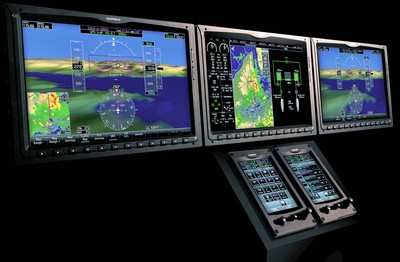Wed, Jul 21, 2010
Garmin Says New Technology Brings A "Sixth Sense" To The
Cockpit
 Garmin says it is developing a new stability augmentation
system called Garmin's Electronic Stability and Protection (Garmin
ESP) system. This electronic monitoring and exceedance-correcting
technology for G1000 and G3000 integrated flight decks works to
assist the pilot in maintaining the aircraft in a safe, flight
stable condition, helping in certain situations to prevent the
onset of stalls and spins, steep spirals or other loss-of-control
conditions should the pilot become distracted, disoriented or
incapacitated during flight.
Garmin says it is developing a new stability augmentation
system called Garmin's Electronic Stability and Protection (Garmin
ESP) system. This electronic monitoring and exceedance-correcting
technology for G1000 and G3000 integrated flight decks works to
assist the pilot in maintaining the aircraft in a safe, flight
stable condition, helping in certain situations to prevent the
onset of stalls and spins, steep spirals or other loss-of-control
conditions should the pilot become distracted, disoriented or
incapacitated during flight.
"Until today, this type of stability augmentation system has
only been available on fly-by-wire aircraft that cost millions of
dollars," Gary Kelley, Garmin's vice president of marketing.
In the announcement made Wednesday, Garmin said the ESP
functions independently of the autopilot, and operates "in the
background" whenever the pilot is hand-flying the aircraft. Garmin
ESP gently nudges the controls back towards stable flight whenever
pitch, roll or high-speed deviations exceed the recommended limits.
Garmin ESP will then disengage when the aircraft returns to its
normal flight.
High and low airspeed protection will also be available with
Garmin ESP while pilots are hand-flying the aircraft. If a
Garmin ESP-equipped aircraft approaches the aircraft's speed limits
(VMO or VNE), Garmin ESP engages and applies force to the control
yoke to increase the aircraft's pitch attitude and prevent a
further increase in airspeed. Garmin ESP also has built in
parameters to prevent the aircraft from exceeding G-limit load
factors upon pullout. In high performance aircraft with angle of
attack/lift sensors, Garmin ESP offers low airspeed or stall
protection that reduces the probability of stalling the aircraft by
providing a gentle pitch-down control force through the control
yoke when the aircraft's wing approaches its critical angle of
attack.

Garmin G3000 Flight Deck
Although Garmin ESP is not an autopilot function, it does
utilize the servos in Garmin's GFC 700 autopilot to provide
stability augmentation. The servos for the GFC 700 provide the
sensing, computation and variable control speed and torque, which
in turn makes it possible for Garmin ESP to provide a gradient
stick force that simulates the natural aerodynamic stability of the
aircraft.
Garmin ESP will be offered as an option on select G1000 and
G3000-equipped aircraft. The implementation and functionality of
Garmin ESP will be determined by individual aircraft manufacturers.
The retrofit G1000-equipped King Air 200 will be the first aircraft
to receive Garmin ESP later this year and it will be available at
an expected list price of $17,995.
More News
Terminal Radar Service Area Airspace surrounding designated airports wherein ATC provides radar vectoring, sequencing, and separation on a full-time basis for all IFR and participa>[...]
Very High Frequency (VHF) The frequency band between 30 and 300 MHz. Portions of this band, 108 to 118 MHz, are used for certain NAVAIDs; 118 to 136 MHz are used for civil air/grou>[...]
“From approximately November 2021 through January 2022, Britton-Harr, acting on behalf of AeroVanti, entered into lease-purchase agreements for five Piaggio-manufactured airc>[...]
Also: Virtual FLRAA Prototype, IFR-Capable Autonomous A/C, NS-32 Crew, Golden Dome Missile Defense Bombardier announced that the first production Global 8000 successfully completed>[...]
Aero Linx: The 1-26 Association (Schweizer) The Association’s goal is to foster the helpfulness, the camaraderie, and the opportunity for head-to-head competition that is fou>[...]
 ANN's Daily Aero-Term (05.29.25): Terminal Radar Service Area
ANN's Daily Aero-Term (05.29.25): Terminal Radar Service Area ANN's Daily Aero-Term (05.30.25): Very High Frequency (VHF)
ANN's Daily Aero-Term (05.30.25): Very High Frequency (VHF) Aero-News: Quote of the Day (05.30.25)
Aero-News: Quote of the Day (05.30.25) Airborne 05.23.25: Global 8000, Qatar B747 Accepted, Aviation Merit Badge
Airborne 05.23.25: Global 8000, Qatar B747 Accepted, Aviation Merit Badge ANN's Daily Aero-Linx (05.30.25)
ANN's Daily Aero-Linx (05.30.25)




